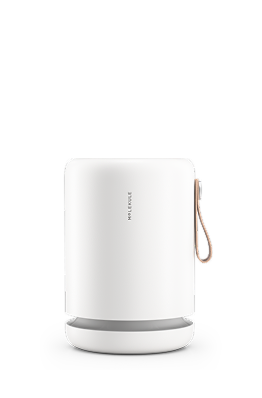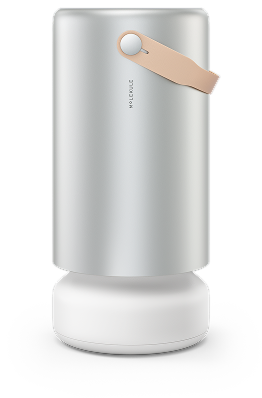Air Mini is Molekule’s smallest air purifier, rated to cover 250 square feet of space. While it may be small, the Air Mini is mighty. It features patented PECO technology that can destroy airborne organic material such as infectious pathogens and airborne chemicals. Air Pro is our newest purifier, and is rated to cover a whopping 1,000 square feet of space. It also uses our PECO-Filters that remove viruses from the air and also capture particles and destroy volatile compounds.
Another step in our constant testing of our products is to test them specifically on bioaerosols. This group of airborne pollutants include potential pathogens like bacteria, mold spores, and viruses. We are always doing different experiments to bring our technology even further and bioaerosol testing is a natural part of that.
The air quality experts at Intertek challenged Air Mini and Air Pro with a series of different bioaerosols. The purifiers were able to remove them from the air, but let’s take a close look at the different organisms and how they correspond to our world.
Bioaerosols are everywhere
Living things cover every surface of this planet except for a few spots with extreme temperatures. They are common in the air, as well. Every form of life produces its own substances that end up floating around. Most animals give off smells and shed tiny particles of skin or hair. Plants can throw dense plumes of pollen into the wind. Fungi often reproduce by spreading spores. Bacteria may also take advantage of passing currents in search of newer or better places to find food. And most of us are well-aware of viruses like COVID-19 or the flu that spread via airborne particles.
Bioaerosols cause allergic rhinitis or the typical allergic reaction of a runny nose, itchy eyes, and sneezing in. Proteins in the saliva of cats or on the surface of dogs’ skin contain allergens, which react with our immune systems to make us sneeze, cough, or make our eyes watery and itchy. Many species of plants produce pollen with allergens that can infiltrate our nose or mouths. Some people even avoid going outside during certain seasons to avoid the drastic reactions of their immune systems to this type of bioaerosol.
Mold spores, a type of fungus, are another slightly more insidious bioaerosol, because pollen from plants doesn’t typically grow new plants in your home. Mold spores are different. If they land in a spot with enough moisture and food, they can germinate and grow into a mold colony that will release more spores. There are allergens and toxins in mold spores, so it’s always best to take care to clean, disinfect, and perhaps replace anything with mold growing on it in your home per the EPA’s guidelines.
Microorganisms like bacteria and viruses are other bioaerosols of interest. Bacteria are usually much larger than viruses but still too small to see with the naked eye. Diseases like tuberculosis and Legionnaires Disease are typically spread by airborne bacteria. It’s been established that SARS-CoV-2, the virus responsible for the COVID-19 epidemic is transmissible as an aerosol, as is influenza, measles, and other viral diseases.
We have already done a lot of testing on how well Mini and Air Pro can capture particles that allergens might ride around on, so for this testing we decided to focus on the potentially infectious pathogens – bacteria, viruses, and mold spores.
Test parameters
Testing the removal of bioaerosols from an indoor environment has not been standardized by the air purifier industry. We worked with Intertek to develop a method that was reliable and reproducible.
First, we decided on species that would well-represent bioaerosols commonly encountered in the world:
Aspergillus niger. A. niger is an extremely common black mold. It usually grows on food like onions or peanuts, as part of a mildew colony, or pretty much anywhere it can find plant matter and moisture to consume. This species is rarely capable of infecting humans, but can still cause allergic reactions.

Zoomed in A. niger, each spore-bearing vesicle is around 50 microns wide. The attached spores are anywhere from 2 to 5 microns.
Escherichia coli. E. coli is a ubiquitous bacteria in the human environment because it lives in our lower intestines and the intestines of many other mammals. It has a reputation for food poisoning, but only a few strains are capable of causing any discomfort. This bacteria is capable of surviving in the air for several hours.

E. coli through a microscope. Each cell is about 2 microns long.
Coliphage Phi-X174. This tiny virus has long been used as a model for aerosolized viral capture by air filters. Its individual virus particles are only about .03 microns in size, so they are among the smaller viruses available, smaller than coronavirus or influenza. Phi-X174 only infects bacterial cells, so it’s safe for the researchers to work with and doesn’t require advanced biosafety facilities.

The physical structure of Phi-X174
Intertek suggested the use of their sealed 1,000 cubic foot (10 by 10 by 10 feet) chamber, which is about the size of a small bedroom. The chamber is equipped with a special sprayer to aerosolize millions of organisms into the chamber and a pump to sample the air at regular intervals. The unit is then left in the chamber for 24 hours before the filter is extracted and checked for the presence of the organisms.
After each test, the unit was removed from the chamber and the organisms were sprayed in again. Air samples were taken at the same intervals to compare against the air cleaned by the purifier.
Each sample of air is pumped into an impactor, a sealed plate to which any airborne organisms will adhere. The plate is then extracted into a solution which is spread on a nutrient gel to check for the number of viable organisms in each sample. This method relies on being able to visually count individual colonies so high concentrations can’t be quantified because they fill the nutrient plate. To account for this, researchers establish a reasonable floor value of 2,628 colony forming units for situations when enumeration is not feasible. Though there is this drawback, there is the advantage of being able to detect very small amounts of organisms in the air.
Molekule air purifiers remove bioaerosols
The results need a little interpretation, but are more or less what we expect.
Air Mini
Air Mini is rated for rooms similar in size to the test chamber. In the two hour duration the device ran, it reduced the presence of airborne organisms significantly. Here is a table of the number of organisms per cubic foot sampled from the three Air Mini tests. Please note that “TNTC” means “too numerous to count.”

In the control test for natural decay in the chamber, the team found the concentrations for all organisms to be too numerous to count at all time points.
Due to the limitations of the method, it is a little difficult to interpret the first hour of the test. This includes the initial concentration at time point 0. However, the reduction of airborne organisms by an air purifier should fit a curve. Adding order 2 polynomial trendlines to the Air Mini data fits the points we do have quantified well, and looks like the following.

Order 2 polynomial curves (dotted lines) over the Air Mini data (points). Removal percentages from Intertek calculation.
A. niger R squared = 0.967, E. coli R squared = 0.997, Phi-X174 R squared = 0.929.
This gives us a better interpretation of the data. It is unlikely that 100% of the organisms sprayed into the chamber were aerosolized, so extrapolating from the measurements starting at 60 mins the initial concentration was several thousand organisms per cubic foot. This extrapolation allows for a reasonable fit in situations when it was not feasible to physically count thousands of organisms growing on the nutrient plates. At 60 minutes considerably more than half of the organisms were gone, and by two hours around 99% were not detectable. No organisms were detected on Air Mini’s filters.
You can view the Air Mini Bioaerosol report from Intertek here, please note the numbers above have been converted to organisms per cubic foot from organisms per 3L sample.
Air Pro
Our latest air purifier, Air Pro, is much more powerful than Air Mini and is rated to clean four times more space. Air Pro was expected to fare much better in this test, so the test was only run for one hour instead of two. Let’s look at the raw number of organisms per cubic foot for each time point.

Like with the control test for natural decay with Air Mini, the control test for Air Pro measured too numerous to count for all timepoints.
With Air Pro the upper limit issue did not come into play at any of the time points after zero. It is important to note that it still had the quantification issue at time point 0. By the first sample the number of organisms in the air was quantifiable.

Removal percentages from Intertek calculation.
Roughly the same volume of organisms was released into Air Pro’s chamber as was into Mini’s chamber, so the initial concentration of the organisms was probably thousands per cubic foot. Air Pro was able to reduce the airborne organisms to the bottom limit of detection within 30 minutes, and was able to reduce their concentration to undetectable after 45 minutes. In this case, Air Pro’s ability to clean the air outperformed the method at the planned air collection samples. It is not feasible to perform the same type of extrapolation, as there are simply not enough non-zero data points. If this test were repeated with the same instruments, additional samples below the 10 minute sample point would allow for a better representation of the cleaning done by Air Pro and facilitate extrapolation. Extracting the Air Pro filter did not yield any viruses or bacteria, but a barely detectable amount of mold spore was recovered from the filter.
You can view the Air Pro Bioaerosol report from Intertek here, please note the numbers above have been converted to organisms per cubic foot from organisms per 6L sample.
Molekule PECO-Filters don’t just remove organisms from the air, they destroy them by oxidizing them on the surface of the catalyst. Keep an eye on this blog for more performance data and experiments on our devices!
It’s important to remember, while air purifiers can provide an additional layer of protection to help reduce potential viral exposure, Molekule encourages use of PPE and medical countermeasures suggested by government authorities. Molekule air purifiers have not been tested on COVID-19. A. niger, E. coli, and Phi-X174 courtesy of Wikimedia Commons, part of the Wikimedia Foundation.







